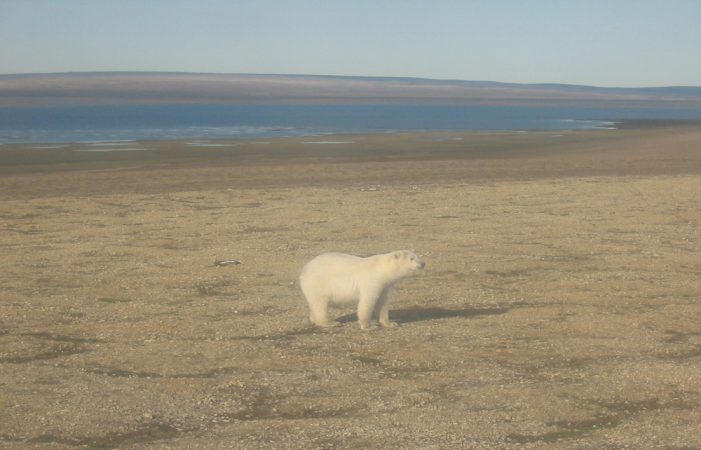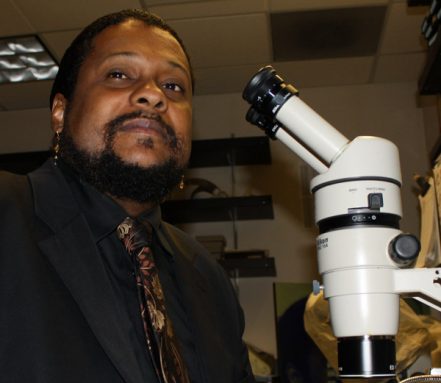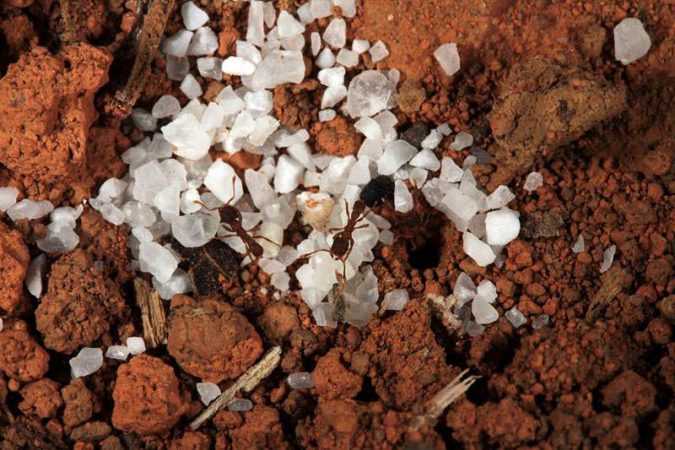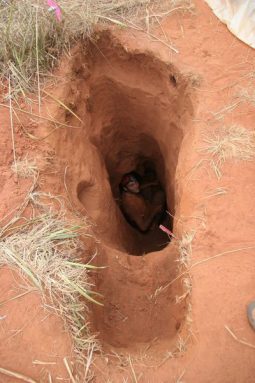Cool Jobs: Wild science
Discouraging polar bears from joining you for breakfast, avoiding hippos that might bite you in two and learning to bathe in caiman-infested rivers are not part of a scientist's traditional job verbal description. But if you'rhenium a field researcher — someone who gets tabu of the research laboratory to pile up and analyze data — you may want to lord some of these skills.
Of class it's not whol drama, say three field researchers who have roamed far and panoramic in the name of science. When your workday is done, and you find yourself a long way from civilization and video games, you may just have to take upward … knit.
"You're expiration to have downtime," and plenty of it, says Kathy Young at Toronto's York University. Her studies of hydrology — how water moves within Earth's environment, from the transmit to deep underground — take her to the Arctic. To pass the time, "Multitude have to know how to knit, read for pleasure surgery play cards," she says.
Simply in between escape boredom and dangerous wildlife is the skill — collection samples, taking measurements and observing captivating things all but the natural world.
Bears? Oh my!
Young is exploitation her degrees in biological science and geographics to physique impossible how Arctic wetlands and ponds are responding to climate fluctuations. Are the warmer temperatures associated with clime change drying Arctic sites? Are such temperature increases affecting the amount of coke, Beaver State thawing permafrost? Are the types of plants that grow in the Arctic dynamical? And how do all of these things fit together to create a fit, or perhaps unhealthy, ecosystem?
Young has discovered that some Frigid ponds and wetlands are indeed drying out, and she worries about what that might mean for the animals and hoi polloi who depend on such watery habitats. These areas act every bit grocery stores in a place where food for thought terminate embody rare. Musk wild ox, caribou and migrating birds exhaust the wetlands' grasses, flowers, herbs and seeds. The Inuit (native peoples) in turn hunt these animals.
When Young works up north, she often stays for months at one time. She shares a small cabin with a few of her students on the other unoccupied Bathurst Island, about 145 kilometers (90 miles) from the closest community.
Because the cabin is so unintegrated and because she shares the island with polar bears, Young must radio a base coterie twice a day. If she misses two calls in a row, people at the camp will alert to the island to check connected her.
While she's never needed rescuing, Young has had enough interaction with the island's wildlife to be pleasant for the stand-in.
Once while she was cooking breakfast in the cabin, one of her students happened to glance at the ajar windowpane. "He aforesaid, 'What is that white affair in the window?'" At initial, Young didn't pay overmuch attention. After wholly, she sees a lot of Frigid Zone foxes and wolves. "Merely then I saw the polar bear's pass in the window," she says, "and I saw we'd left the hit man right by the window."
Young reacted instinctively: She ran to the windowpane "and slammed it along his nose."
The bear backed up enough for her to grab the gun. Unspoilt affair, too, because after ab initio moving absent from the cabin, the assume came back. So she stepped away and fired off a few rounds into the air. After that, he turned tail and ran.
The lesson for field researchers in the far north? Forever, ever keep your gun with you, and learn how to make the right decision quickly, Young says.

From frogs to hippos
Spell it's groovy to come through back from the field with jeopardize stories, you should plan your trip well enough that none of those adventures gets in the way of doing your work — or worse, says biologist Tyrone Hayes. At the University of Golden State, Berkeley, helium studies the effect of commercial chemicals on amphibians.
The first sentence Hayes travelled to Kenya, in East Africa, he knew to be wary of lions and leopards. Only unity night while looking frogs with a scholarly person from Kenya, the scholar looked nervous. Hayes was nonplussed because in that respect were no threatening animals nearby. When Hayes asked if IT was safe for them to be there, the fellow secure him it was but remained intelligibly frightened.
That's when Hayes noticed about holes in the lakeside where they were working. Helium asked the Pres Young Kenyan what created the holes. "'That's the hippos,'" the student told him, explaining that the animals walk around at night to course. So Hayes asked again whether it was safe to be out there. The student replied, "If a Hippo Regius sees you, she will bite you twice." Helen Hayes wondered what that meant.
There was a slight language problem. It clad that the student was trying to tell Hayes that the hippo would bite its dupe in half.
Though Hayes has been careful non to disturb hippos ever since, the possible action of a run-in with i hasn't unbroken him from fieldwork. And that's a good thing. Years later, the man of science unconcealed something very important about how certain chemicals might cost leading to a drop in worldwide frog populations.

Hayes has a background in evolutionary biology (the study of natural biological changes in bread and butter populations), endocrinology (the study of hormones, chemicals that the body makes to direct the timing of important activities) and molecular biology (the study of chemicals essential to lifespan). Combine his knowledge from these different fields, He created research laboratory experiments to test what might be causative the drop in frog numbers.
His experiments showed that some male frogs living in water mercury-contaminated by a common weed killer called atrazine had shrunken voice boxes. This made it voiceless for the males to yell to electric potential mates. Some frogs exposed to atrazine had malformed reproductive organs that made it fractious or impossible for them to reproduce. And in more or less cases, frogs born manlike became female. They non only looked the like females but could bear current young (although complete their offspring were males).
Today, Hayes is positive these changes stimulate to do with how atrazine interferes with frog hormones. Hormones are natural chemicals that all living animals produce in their bodies. The chemicals act as messengers, serving to moderate how cells and organs do their body of work.
Hayes' findings may exist important not only for frogs simply also for humans WHO produce umteen of the same hormones As frogs. The biologist's studies helped timesaving the U.S. Environmental Trade protection Agency to re-examine how safe atrazine is for humans.
Mass's activities are creating environments where some things can no yearner live safely, Hayes warns. And if commercial weed killers and other chemicals are responsible for, that's worrisome, he says, because there's nothing unparalleled about the frog's world. "We are living in the same environment and breathing the same air."
Emmet farming
While Hayes combined his shape in the field of force and the science laborator to dig into the effects of an environmental contaminant, fieldwork can likewise uncover just plain fascinating insights into the earthy worldly concern.

Jeffrey Sosa-Calvo, for example, studies complex societies of fungus-growing ants in Guyana and Brazil. Out of the 13,000 or so known species of ants, on that point are roughly 250 that grow fungus for food, he explains.
"Think of them as farmers," says Sosa-Calvo, an entomologist, operating room scientist who studies insects, at the University of Maryland in College Park. "They observed agribusiness about 50 million years ago. Man discovered it 10,000 years ago." So maybe these ants have something to teach US nigh how to structure a gild to reach certain goals, he suggests.
Sosa-Calvo points out that from each one individual in an ant dependency has a specific job to do to the primo of its ability. Around ants take in decaying organic affair such atomic number 3 beetle feces to contribute back to underground colonies. At that place the ants use the matter to fertilize — encourage the growth of — the fungus that their settlement eats. Some ants need care of the larvae, Oregon baby ants, while others construct surreptitious chambers for the fungus garden, invite out the garbage or defend the dependency with mandibles (mouthparts carnassial enough to cut skin). And naturally there is the queen ant, whose job it is to give birth to more ants.
To observe these complex ant societies, Sosa-Calvo sometimes spends months in the jungles of South America. There he tracks insects just 2 to 3 millimeters long and the coloration of soil. To help him see the midget camouflaged creatures, helium sprinkles dried emollient of rice connected the ground and waits for the ants to take the bait. When they head base carrying the white grains, Sosa-Calvo tush escort them well enough to follow.

But even with lure, they'ray not always available to find. Sometimes it's not enough to be resourceful; you also take up to constitute longanimous. Sosa-Calvo once spent 10 days searching the hobo camp, much of it in the pouring rain. And his measly reward? Just one ant.
Still, he loves field research, straight-grained when his study subjects are scarce. "I get to see places I never dreamed of," he notes. "You'd give to take a canoe and travel for days to come across other human. Information technology's great."
Helium even loves the chance of bathing in jungle rivers that are home to piranhas and caimans (a relative of crocodiles). But just to be careful, he always brings along a buddy to keep an eye out and get help in case something happens.
"When the caimans go down low-level the water and you tail't determine them anymore, that's the part that freaks you out," he admits. Sosa-Calvo also confesses to being frightened one morning after helium awoke to find jaguar prints in the dirt below his hammock.
But when asked if He could be talked into cutting back along fieldwork, Sosa-Calvo does non hesitate: "What? And misfire all that? When I'm there, I mean 'Oh man. I could just rest here forever.'"
Power Words
geographics The survey of Terra firma's features and how the living and nonliving parts of the planet affect one other.
permafrost Permanently frozen ground.
ecosystem The plants and animals found in a taxonomic category place that rely on each other to survive.
Inuit A group of people indigenous to Northland America and parts of Greenland and Northeast Siberia.
hormones Cancel chemicals that all support things raise in their bodies. These chemicals play messengers, serving to control how cells and organs do their knead.
reproductive variety meat The organs in a fauna's dead body that allows it to make babies.
wholesome A substance that comes from plant or animal matter.
This is one in a series on careers in science, technology, engineering and mathematics successful possible by support from the Northrop Grumman Foundation.

0 Response to "Cool Jobs: Wild science"
Postar um comentário